Mark Shaw
- worked for Good Morning America in Philadelphia as a legal Correspondent
- Former CriminalDefense Attorney
While he was living in Colorado, he was referred to Good Morning America and he was sent to Philadelphia because there was a mafia lawyer that who said he would talk Mark.
Shaw interviewed him and was surprised at what he told him about the mafia trying to get their hands into the gambling in Atlantic City.
The interview aired on Good Morning America.
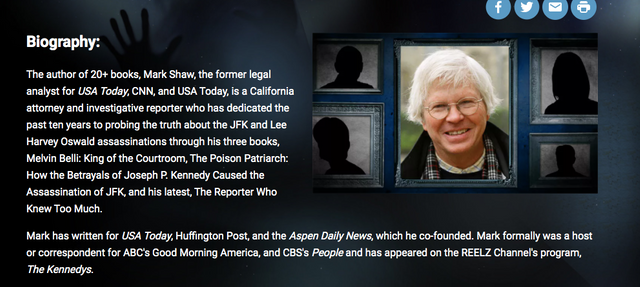
Books written by Mark Shaw
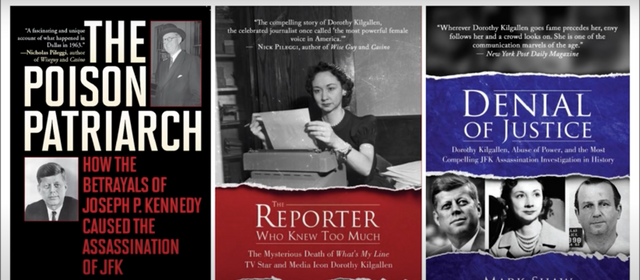
After the interview when Mark Called for a 2nd one, his secretary told him that when the mafia attorney started his car that morning it had blown up.
Which is yet another example of how people are threatened and killed by those who want to keep their dark deeds hidden.
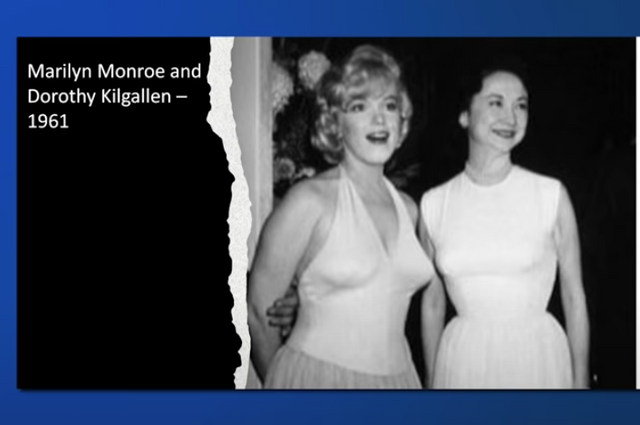
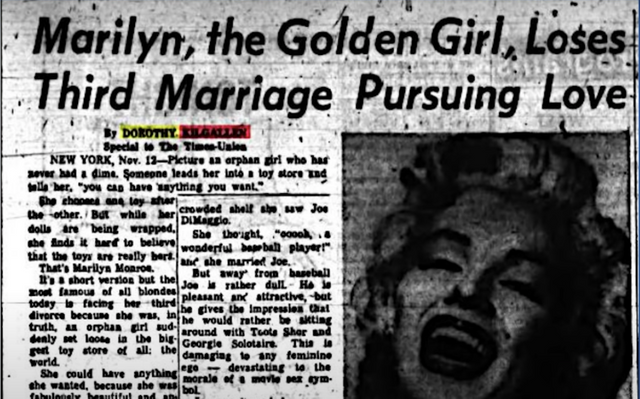
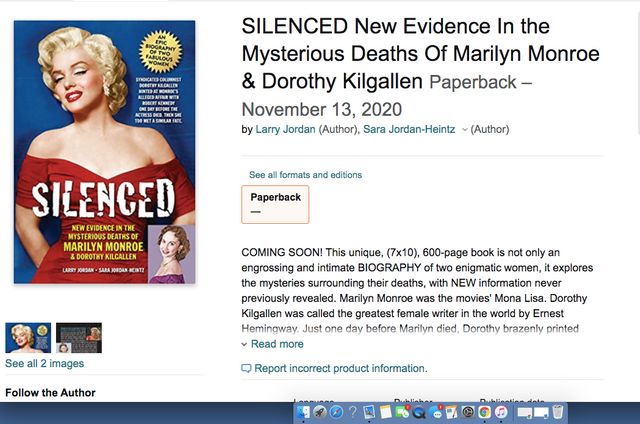
They each confided to friends they knew dangerous secrets, and within hours prior to their deaths, confronted men in their lives whose alibis were easily challenged. Key witnesses were never interviewed; those who were, told conflicting stories. There were perfunctory investigations, glaring contradictions between autopsy results and the implausible "official" findings, disappearing forensic evidence and the premature announcement of the cause of death before any factual basis could be determined. Important and confidential papers went missing and friends were certain the women had been murdered. The intriguing overlap between Marilyn Monroe and Dorothy Kilgallen and the colorful lives they lead has never been explored until now. Award-winning investigative journalists Larry Jordan and Sara Jordan-Heintz dispel rumors and present new facts in this meticulously researched true crime thriller!
Marilyn had been to Dorothy's home for parties and such.
Marilyn died on August 4, 1962
There is an article that came out on her from August 2, 1962 by Dorothy Kilgallen talking about Marilyn being on the upswing, meeting a great new man and everything going well for her.
Does that sound like someone who would commit suicide?
Were there parallels to Marilyn and Dorthy's deaths?
After her masseur stated how she was doing so well. . .why was this what the media reported?
Just as it happened in the Kilgallen case when they gave out the wrong medical examiner headline.
The media's headline in both of these cases tarnished these women's reputations forever and didn't cover the facts.
Dorothy Kigallen's autopsy was very fraudulent and botched. Was this the same in Marilyn's case? You decide!
Then they changed their original findings to this,
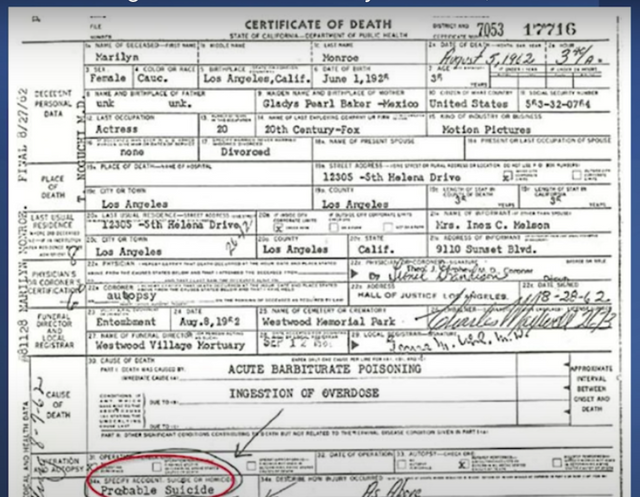
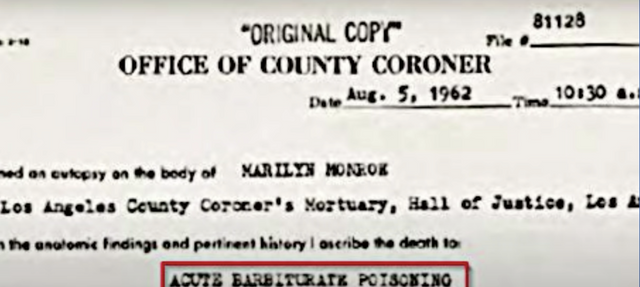
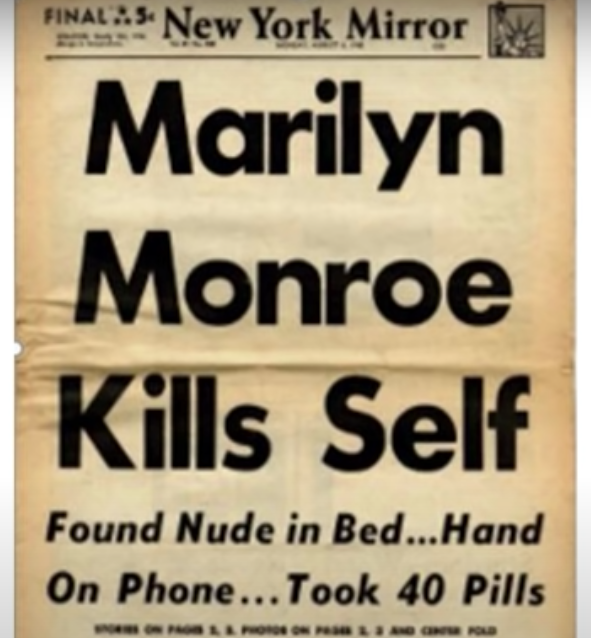
Dorothy asked in an article,
Why was Marilyn's light left on when she slept in the dark?
Why was she found in the nude, when she didn't sleep in the nude?
Why were her doctor and psychiatrist called and then they said they came there at different times?
They claim she died ingesting 40 pills, where's the glass in the death scene?
An in depth read on Marilyn Monroe is the book called Fragments.
Beyond the headlines―and the too-familiar stories of heartbreak and desolation―was a woman far more curious, searching, witty, and hopeful than the one the world got to know. Now, for the first time, readers can meet the private Marilyn and understand her in a way we never have before. Fragments is an unprecedented collection of written artifacts―notes to herself, letters, even poems―in Marilyn's own handwriting, never before published, along with rarely seen intimate photos.
Jotted in notebooks, typed on paper, or written on hotel letterhead, these texts reveal a woman who loved deeply and strove to perfect her craft. They show a Marilyn Monroe unsparing in her analysis of her own life, but also playful, funny, and impossibly charming. The easy grace and deceptive lightness that made her performances indelible emerge on the page, as does the simmering tragedy that made her last appearances so affecting.
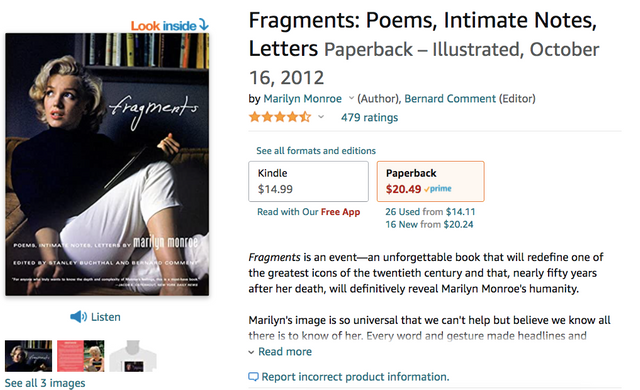
The only photograph of these 3 taken together,
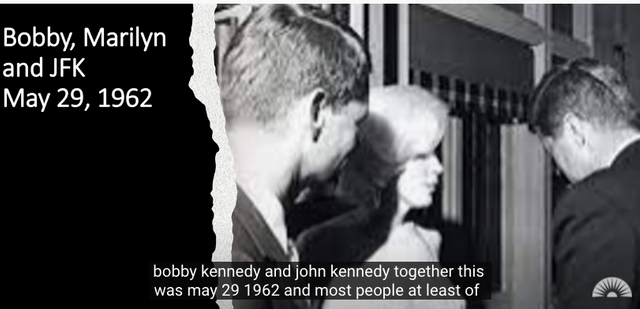
From Jean Kennedy Smith, the President's sister to Marilyn,
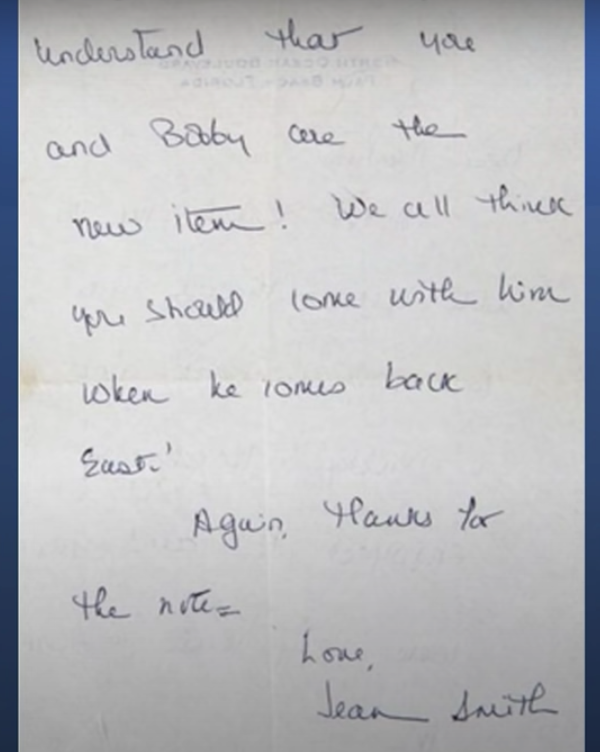
CIA verifies relationship with Bobby Kennedy.
Were they lying?
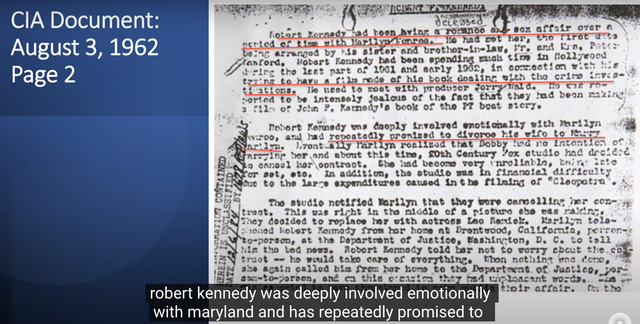
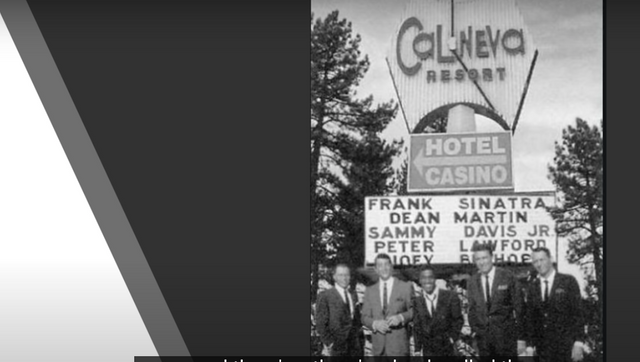
The week before Marilyn died, there was a book that came out by Gianni Russo
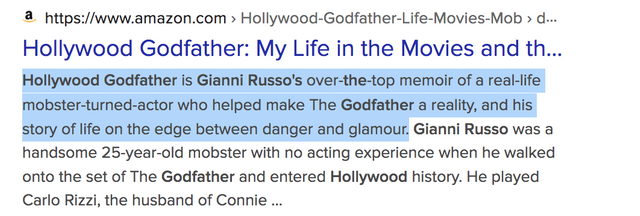
Russo was a mafia runner for Frank Costello in New York.
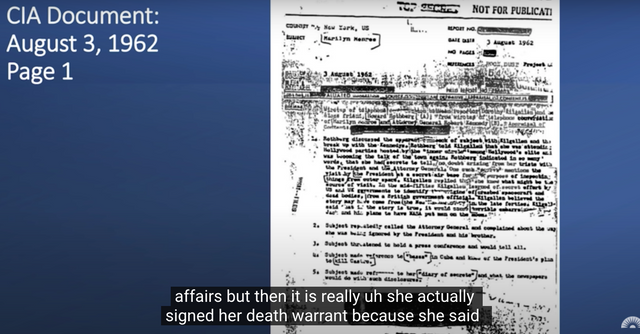
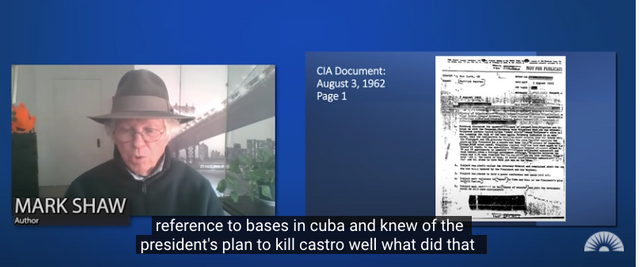
The Strange Death of Marilyn Monroe was written at that time.
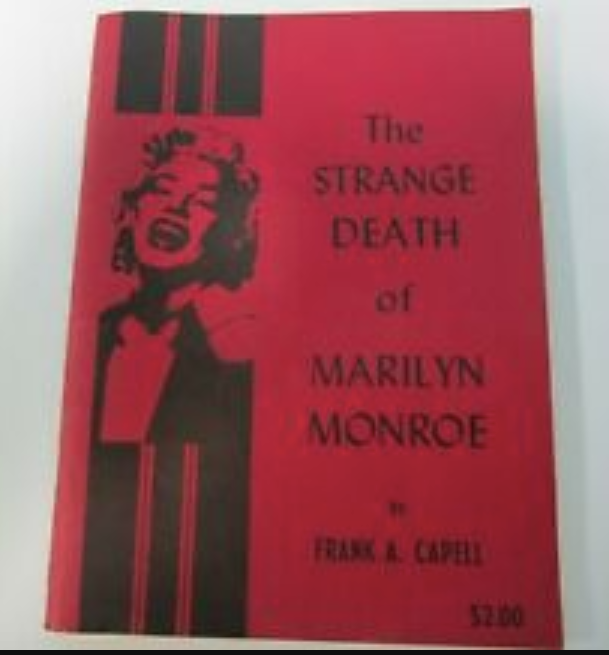
Here is the book review by David Marshall, who clearly cannot stand the author, his viewpoints nor the book itself.
For those who have studied the case, Capell’s booklet is more of an artifact, a time capsule of the far right wing propaganda circa the early 1960s. Liken the book to coming across an old John Birch Society tract or a measure of the depth of animosity against the Kennedy Administration while the “brief shinning moment” was still a commonly held belief. The Kennedy Years are usually thought of as a period of style and grace. It is the underbelly of the nation at that time, the dozens of fringe groups whose existence really came to light only after Dallas, that Strange Death personifies. The book, (although containing many crisp and clear copies of documents, as well as contemporary newspaper clippings), is sought out not so much for what it says but for the fact that it has become a dark talisman of the times, a reminder that not everything of that era was as clean and wholesome as Marilyn’s smile. It was an era of Disneyland, Cinemascope and Life magazine. But it was also an era of radical politics of hate, simmering paranoia, and backroom mechanisms that resulted in violent death. Mr. Capell’s book brings all of that to the forefront.
If you are looking for new information, you won’t find it here, (unless you are searching for Pat Newcomb or Dr. Greenson’s 1962 street addresses). What scant information the booklet holds has been reprinted in many of the better written and more widely distributed books that have since reached publication. But for a feel of the times, of the staunch anti-Kennedy, anti-Communist, high morals preaching of the far right, the book exceeds anyone’s dreams. I knew all this going in, of course. What I was not prepared for was the intensely vitriolic language. And the condemnation of Marilyn Monroe. In the tradition of blaming the victim that seems to be a part of America that continues to this day, The Strange Death of Marilyn Monroe paints its central figure not only as a Commie but as an immoral Commie who got what she had coming.
Capell, in his introductory “About the Author” is upfront about his Anti-Communist credentials. As editor of the “Herald of Freedom,” (“a national anti-Communist educational bi-weekly”), Mr. Capell had been fighting the reds since long before WWII and, as of 1964, was still fighting.
http://www.marilynmonroe.ca/camera/books/89.html
The FBI sent the book to Bobby Kennedy and asked for his reaction.
Shaw has an FBI memo where agents and the Kennedy's were ordered to go out and buy as many copies of the book as they could.
Which appears that they were scared to death of the book and didn't want it in the hands of the media.
If some of it was speculation, why did they want the book kept out of people's hands?
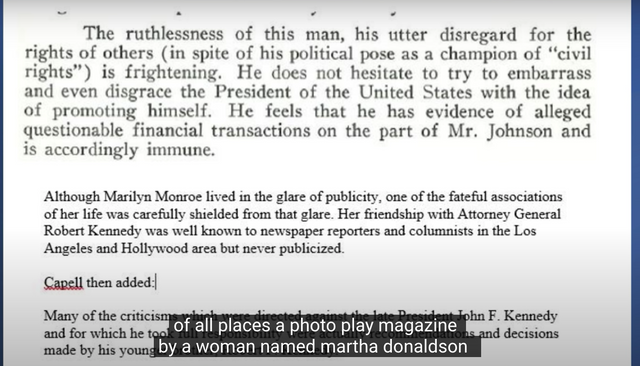
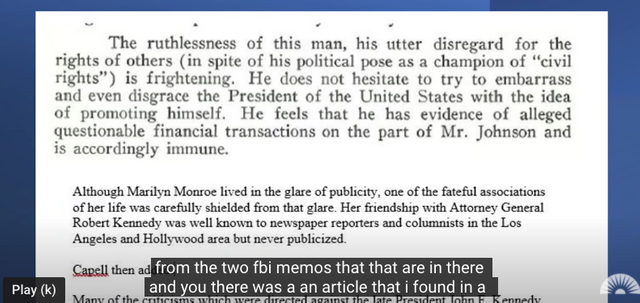
Martha Donaldson had interviewed a lot of Marilyn's friends.
Who is Donaldson talking about?

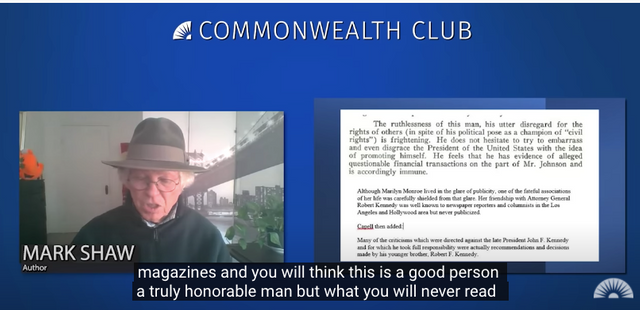
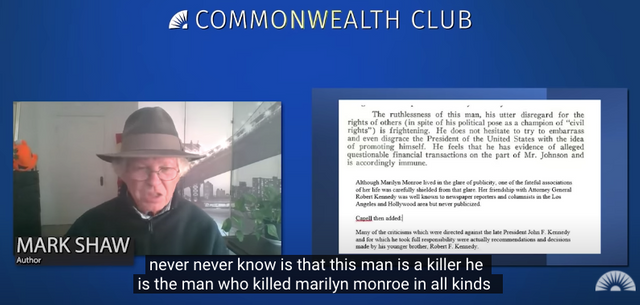
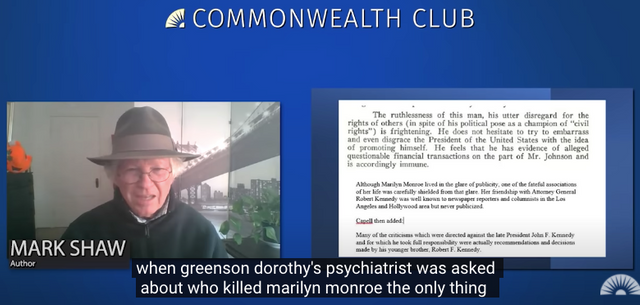
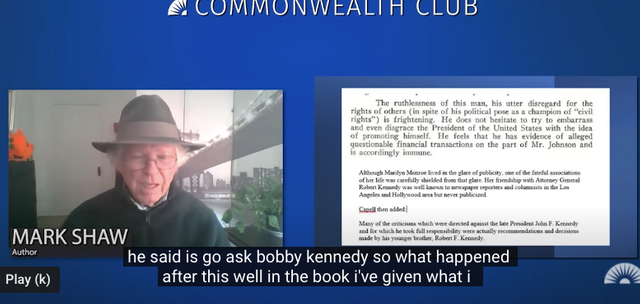
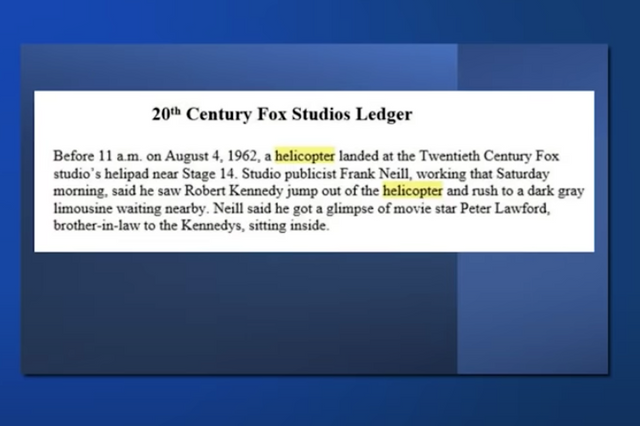
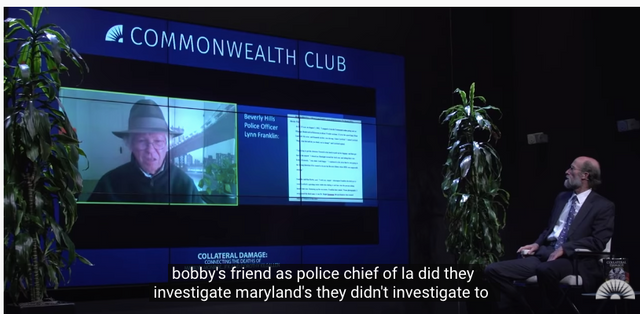
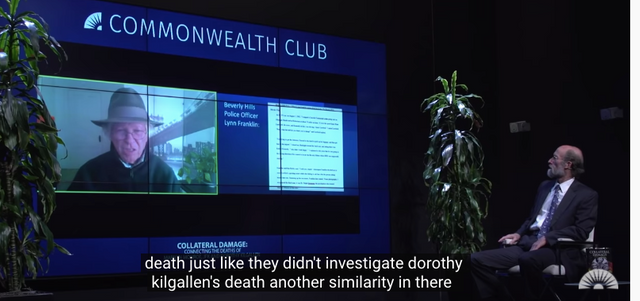
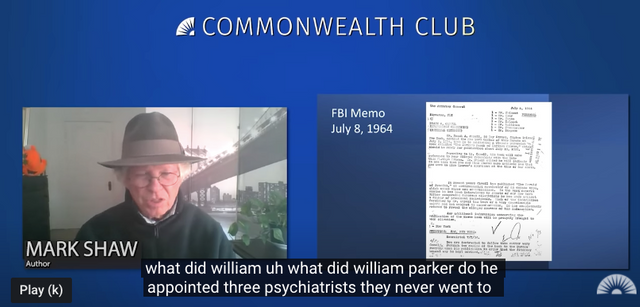
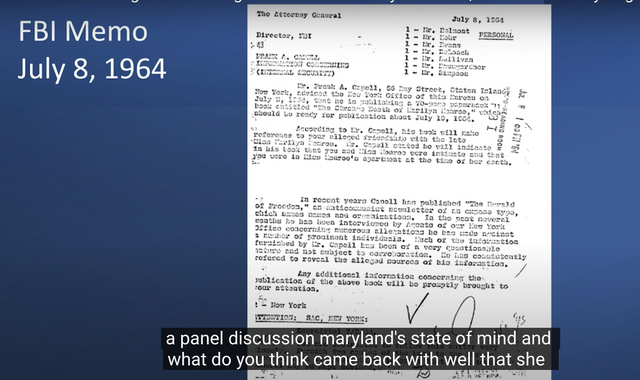
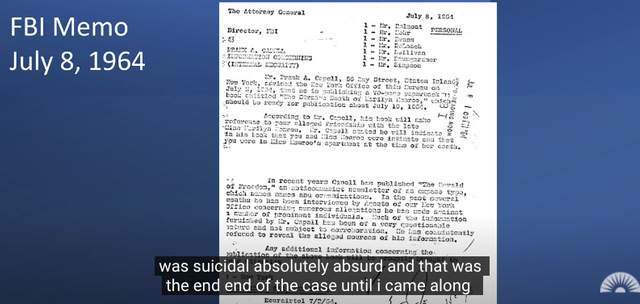
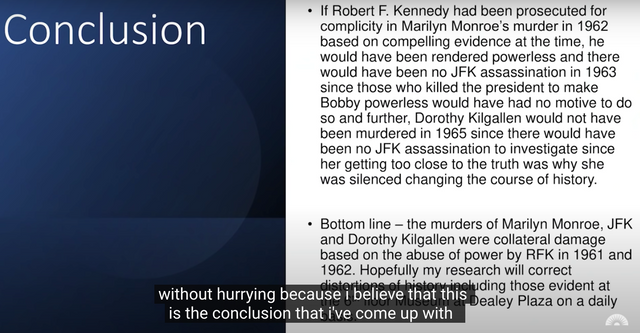

https://www.history.com/news/joseph-kennedy-wealth-alcohol-prohibition
So did Joe have JFK appoint Bobby.
He did go after the mafia including Marcello and this was a case Kilgallen was working on.
Did Joe Kennedy initially have a deal with the mafia that if they helped get JFK elected, they would leave the mob alone?
Then did they renege on this deal as Bobby did go after them?
Marcello had even said after he had been deported and charged with racketeering, "I can't let this happen, I've got to render Bobby Kennedy powerless! But if I kill him, JFK will come after me with everything the government has. But if I kill JFK, Bobby Kennedy will be powerless."
JFK was assassinated and the Jack Ruby possible connection to the mob is an interesting angle.
Dorothy Kilgallen had said if the wrong people knew what she knew about the JFK assassination, it would cost her her life.
She had pieced together Marcello, Lee Harvey Oswald and Jack Ruby.
When Dorothy Kilgallen was asked why she and Frank Sinatra had a feud going, she claimed she turned him down, so then he attacked her.
It is proven he attacked her looks.
They became bitter enemies after being friends at one point.
Before the rumors of JFK and Marilyn, Bobby Kennedy and Marilyn there was Joe Kennedy and Gloria Swanson.
https://news.amomama.com/279837-gloria-swanson-went-absolute-hell-during.html
In the Jack Ruby Trial transcripts Jack Ruby is overheard on the phone saying on the day he shot Oswald, I will be there when he's transferred. I will get help from my police buddies to get into the basement. I will act like a reporter to get to the basement.
Was it obvious he was stalking Oswald? You decide.
Dorothy Kilgallen saw it first hand as she sat through the Jack Ruby trial and was photographed asking questions.
Max Holland - The Zapruder Film Reconsidered
Life Magazine purchased for $150,000 all rights o the Zapruder film.
In today's money that is equivalent to around 1.2 million.
The interview with Connally just a few days later that was broadcast on NBC nationally from his hospital bed in Parkland hospital.
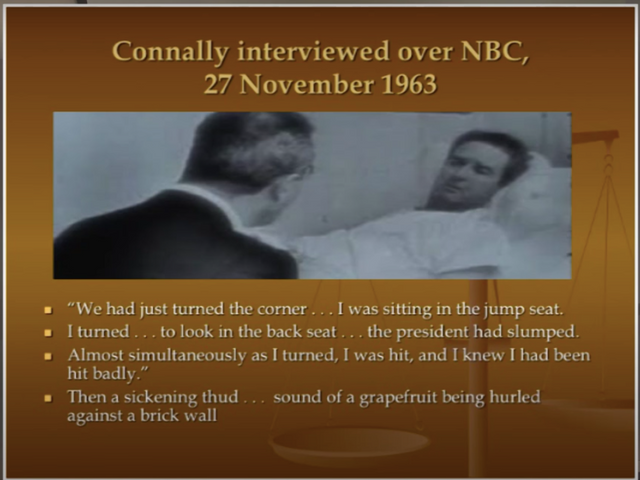
The first line of the LIFE Magazine article set off an initial wave of suspicion over what had really happened.
Take a look.
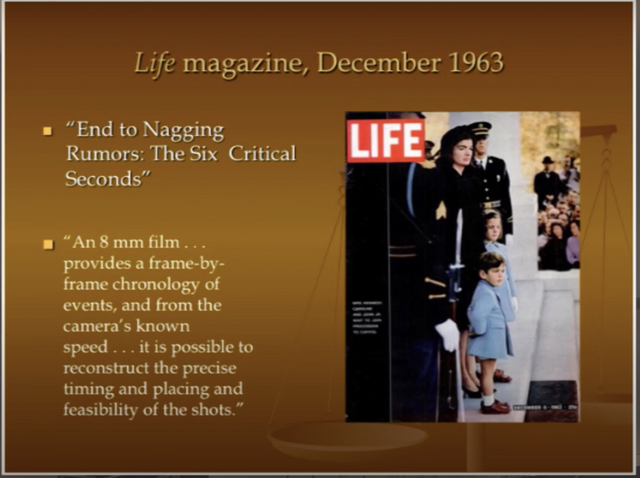
Assassin's view.
Why fire the first shot when an Oak tree is obscuring your vision from right outside the window.
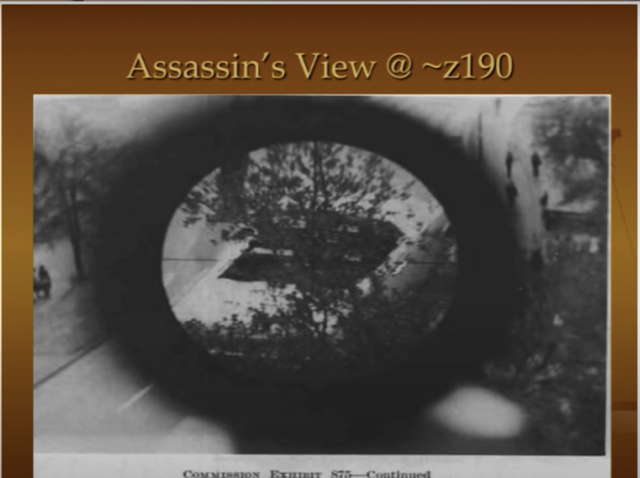
Life Magazine wasn't aware of this because they didn't write their article from Dallas, but rather from New York.
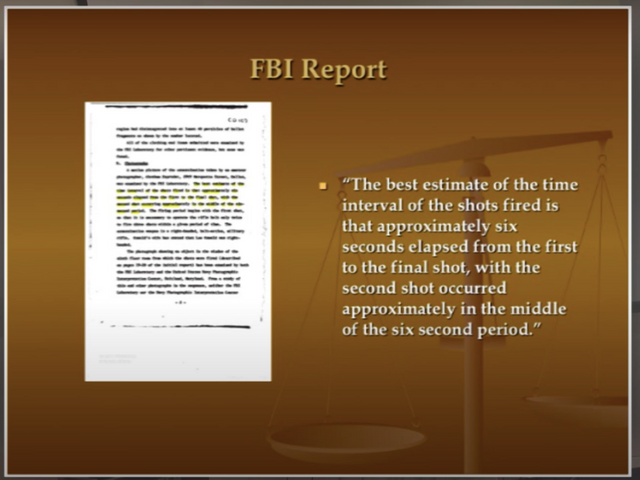
The model the FBI gave to the Warren Commission in 1964
What is wrong with it?
The Warren Commission looked at the Zapruder film in January, February, March and in April they realize there is something terribly wrong.
Norman Redlick, who was a staff council put it in a memo to Jay Lee Rankin, the general council
"The facts which we have in our possession, submitted to us in separate reports from the FBI and Secret Service are totally incorrect and if left uncovered will represent a completely misleading picture."
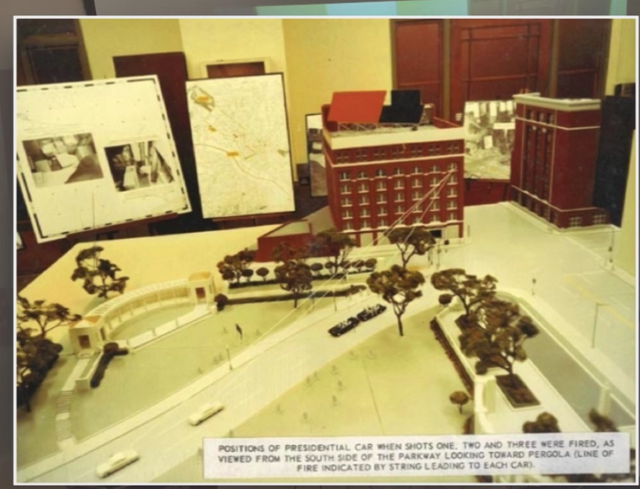
He was referring to the fact that 2.3. seconds was roughly equivalent to the 43 frames of the Zapruder film.
If you looked at the film, there weren't 42 frames of when the president was in obvious distress AND when governor Connally was in obvious distress. WHY?
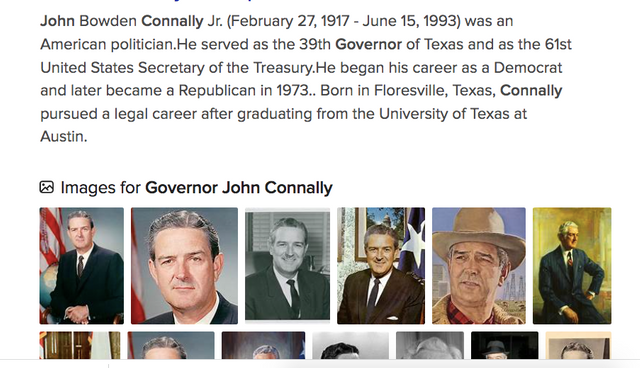
That meant either. . .
- There were two shooters who shot separately and one of them was still at large
- or possibly One bullet went through BOTH men!
Now if there were two shooters is that Not the definition of a Conspiracy? You decide!
So in May 1964, the Warren Commission literally did a Re-staging of the assassination.
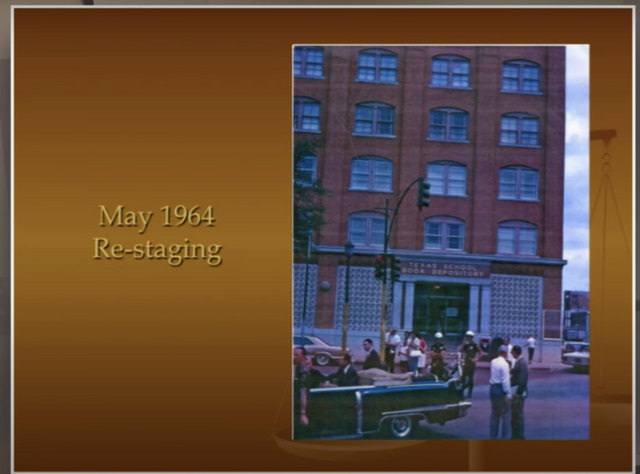
This is something they claimed to never anticipate doing.
They were already supposed to be delivering their report by the time of this re-staging date.
If they could not corroborate that one bullet had gone through Connally and the president then that was proof there was a conspiracy.
They felt they did corroborate it as when you lined them up, a bullet could have hit President Kennedy from the back at 1900 feet per second
Exited his throat at 1700 feet per second
and of course it had to hit Governor Connally.
A magic bullet?
So the Warren Commission added this addition to help everyone along with the forensic science concerning this case.
So if one bullet when through two of them, what happened to the bullet that missed.
The Warren Commission didn't know. They had spent so much time proving that one bullet had struck two people, that they didn't have time to come up with an explanation for the missing bullet.
They really didn't know Which shot fired missed.
It made the most sense that the 3rd shot missed as the president would be farthest away then.
Virtually everyone who testified claimed that the shot to the head was the 3rd shot and the final shot.
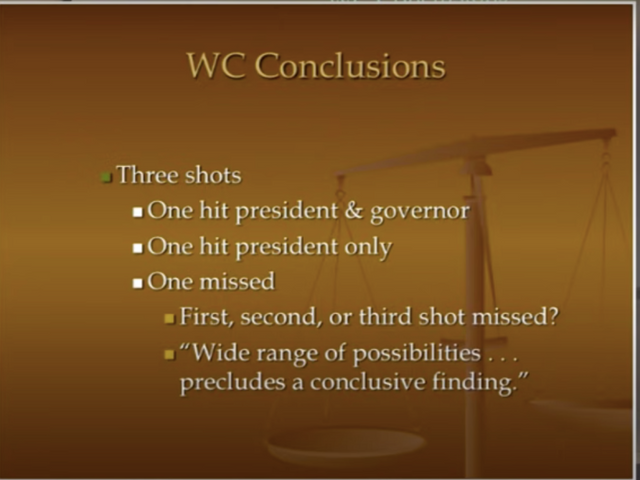
The earlier premise that the Zapruder film was a time clock that was going to show us exactly what happened was not fulfilled.
The Warren Commission was allowing people a different way to choose each time they looked at the Zapruder film.
What they didn't anticipate wasn't just that people wouldn't be dissatisfied with their story, but would believe None of the Warren Commissions options were true.
So HOW was the president killed.
What was the sequence?
LIFE came out with a cover story on there being reasonable doubt that Oswald had killed the president.
The Warren Commission has never recovered.
CBS did something the Warren Commission did not do.
It replicated the exact shooting parameters.
The Warren Commission utilized the FBI's report and tests which used stationary targets.
There's a big difference between firing at a stationary target and an object moving 11 miles an hour!
CBS found that the Warren Commission required Oswald to out perform marksmen at their own trade.
They found it was the rare marksmen that could fire 3 shots in less than 6 seconds and most took far longer. Up to 8.25 seconds.
The second scenario from the Warren Commission was that the first shot hit both men, the second shot missed and the third shot hit the president in the head.
The seconds time frame CBS said was almost impossible to pull that off.
When CBS revisited the assassination in 1975, they had access to the Zapruder film.
They hired a company from Cambridge, ITek which worked for the United States government, the CIA, the national reconnaissance office. They did digital analysis which wasn't as common place back then.
ITek analyzed the Zapruder film and came to four conclusions.
- Could not determine when the first shot was fired
- 2nd shot struck Kennedy no later than frame 223 of the Zapruder film
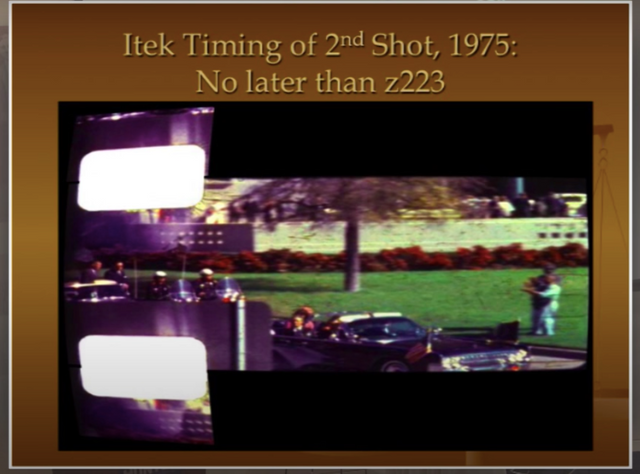
- There was obvious distress by frame 225
- Head motion of the president's head was consistent with the rear entrance of a high velocity projectile.
By the 1990's and early 2,000'swhat authors were saying,
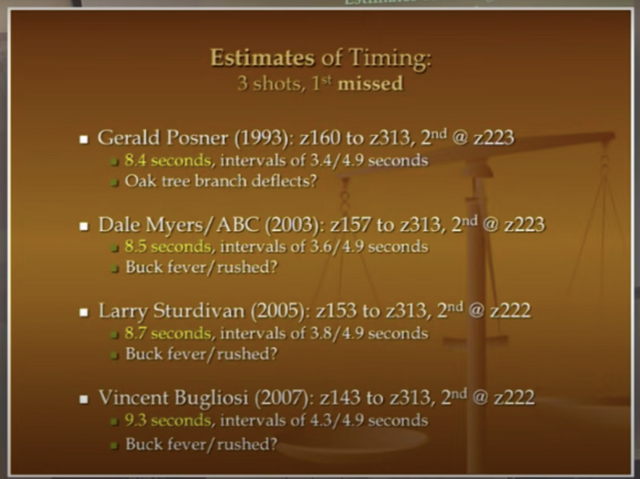
What they all had to say was, just as the car was about to go under the tree, Oswald fired his rifle.
Either it missed because it hit a branch of the tree or due to buck fever.
When a hunter sees a deer, though a very easy shot, the hunter is so excited that he misses.
2nd and 3rd shot took place after the car cleared the oak tree.
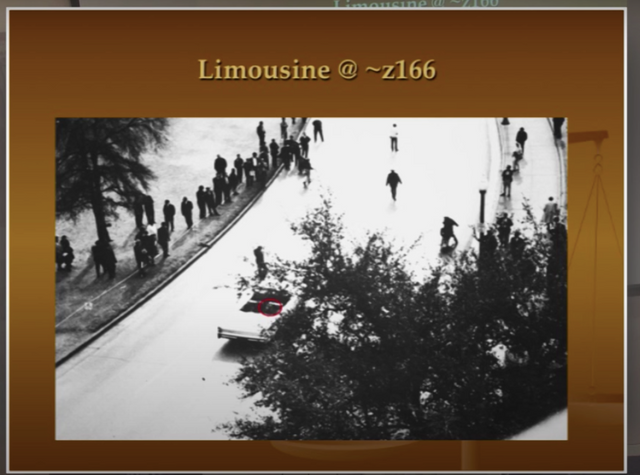
Everything was still viewed within the confines of the Zapruder film.
It was privileged at the expense of other evidence.
One writer from the New York Times critic, Richard Woodward wrote, "the assassination had become so fused with one representation. So much so that Kennedy's death was virtually unimaginable without the Zapruder film."
It really didn't seem an adequate answer to why Oswald missed so badly.
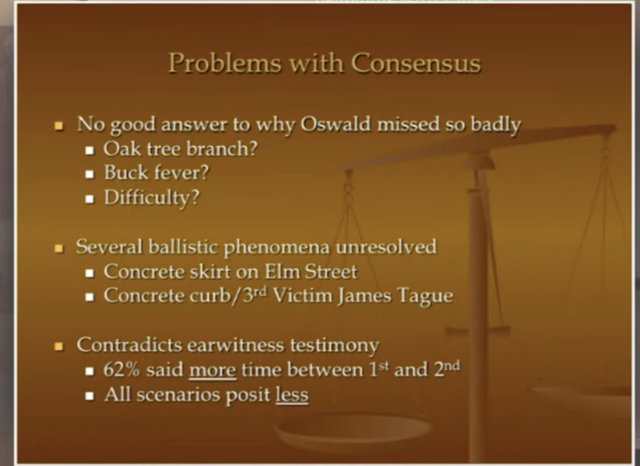
He missed
- the president
- everyone else in the car
- he missed the car which was 20' long, 6' wide at a distance of about 100 or 110'.
That's like the broad side of a barn. So how could he miss even if he hit a tree branch? There is no way it would be deflected that much.
Ballistic issues with concrete skirt on Elm Street.
3rd victim James Tague, who had a scratch on his cheek.
Also contradicted what people heard.
62% of the people who were in Dealey Plaza and heard 3 shots, said there was more time between the 1st and 2nd shots than between the 2nd and 3ed.
Yet with all the prior consensus views you had Less time, so the exact opposite. WHY?
In 2007 Max Holland interview Win Lawson.
Lawson was the Secret Service agent, who advanced the trip to Dallas.
When people came up to Lawson after the assassination, they said if it had to happen they were glad it happened on his watch.
Lawson was known to be the type of agent to follow every procedure the Secret Service was supposed to follow.
The problem was with the procedures themselves as having a president ride in an open limousine could never happen again.
Holland wanted to talk with Lawson about a meeting on Monday that had taken place in Dallas between the Kennedy and Connolly forces.
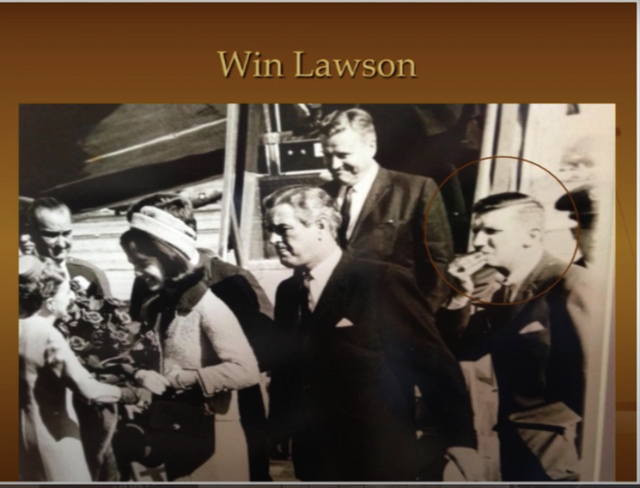
A month before Kennedy had come to Dallas, the ambassador of the UN had visited Dallas. His name was Adlai Stevenson.
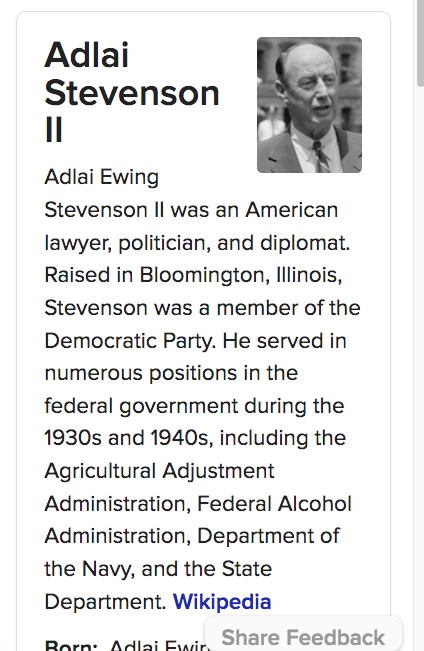
he was a member of the initial U.S. delegations to the UN.
In 1948, he was elected governor of Illinois, defeating incumbent governor Dwight H. Green in an upset. As governor, he reformed the state police, cracked down on illegal gambling, improved the state highways, and attempted to cleanse the state government of corruption.
After President John F. Kennedy was elected, he appointed Stevenson as the United States Ambassador to the United Nations. Two major events Stevenson dealt with during his time as UN ambassador were the Bay of Pigs Invasion of Cuba in April 1961 and the Cuban Missile Crisis in October 1962.
Stevenson served as UN ambassador from January 1961 until his death during a visit to London on July 14, 1965.
His grandfather and namesake Adlai Stevenson I was Vice President of the United States under President Grover Cleveland
In April 1961 Stevenson suffered the greatest humiliation of his diplomatic career in the Bay of Pigs invasion. After hearing rumors that "a lot of refugees wanted to go back and overthrow Castro", Stevenson voiced his skepticism about an invasion, but "he was kept on the fringes of the operation, receiving...nine days before the invasion, only an unduly vague briefing by Arthur M. Schlesinger Jr." and the CIA. Senior CIA official Tracy Barnes told Stevenson and his staff that "there was going to be a clandestine operation in Cuba...it was strictly a Cuban affair. It would have some American cooperation, but only with the training and financing."
as Robert Dallek has written, "by leaving him out of the discussion it led to his humiliation". Unaware that the anti-Castro Cuban exiles landing at the Bay of Pigs were being armed and assisted directly by the CIA and US Navy, and that American pilots were participating in bombing raids of Cuban targets, Stevenson unwittingly "repeated a CIA cover story in a speech before the UN General Assembly". He argued that the rebels were not assisted in any way by the U.S. government; when this claim was proven to be false Stevenson complained that "I took this job on the understanding that I would be consulted and kept fully informed on everything. Now my credibility has been compromised and therefore my usefulness." When he told his friend Harlan Cleveland that his own government had "deliberately tricked" him into believing there was no direct American involvement in the invasion, Cleveland replied "I feel as betrayed as you do." Stevenson seriously considered resigning, but was convinced by his friends and President Kennedy to stay.
President Kennedy remarked "You have to admire Adlai, he sticks to his position even when everyone is jumping on him", and Robert Kennedy wrote that "Stevenson has since been criticized for the position he took at the meeting...although I disagreed strongly with his recommendations, I thought he was courageous to make them, and I might add that they made as much sense as some others considered during that period of time."
Stevenson remarked "I know that most of those fellows will consider me a coward for the rest of my life for what I said today, but perhaps we need a coward in the room when we are talking about nuclear war." In fact, the Kennedy Administration did remove the Jupiter-class MRBMs from Italy and Turkey some six months after the Cuban Missile Crisis ended, and there is evidence that President Kennedy privately agreed that, if the Soviets would remove their missiles from Cuba, he would remove the Jupiter missiles from Turkey and Italy at a later date. The deal was kept a secret for many years, however, and Stevenson was thus given no credit for his original suggestion.
Kennedy told Stevenson that he did not want him to resign and had his Press Secretary, Pierre Salinger, release a letter to the press praising Stevenson's performance during the Missile Crisis.
During his time as UN Ambassador, Stevenson often traveled around the country promoting the United Nations in speeches and seminars. On these trips, he frequently faced opposition and protests from groups skeptical of the United Nations, such as the right-wing John Birch Society.
On October 25, 1963, Stevenson spoke in Dallas, Texas, where he was heckled and spat upon by unruly protestors led by retired General Edwin Walker's "National Indignation Convention". At one point a woman hit Stevenson on the head with a sign, leading Stevenson to remark "is she animal or human?", and telling a policeman "I don't want her to go to jail, I want her to go to school."
Afterwards, Stevenson warned President Kennedy's advisers about the "ugly and frightening" mood he had found in Dallas, but he did not discuss his concerns directly with Kennedy before the president's visit to Texas in late November 1963.
On November 22, Stevenson was attending a luncheon held by the Chilean ambassador when he was informed that Kennedy had been shot in Dallas. He told friends and aides "That Dallas! Why, why, didn't I insist that he not go there?"
As the country moved toward the 1964 presidential election, the war in Vietnam became an important campaign issue. The Republican presidential candidate, Arizona Senator Barry Goldwater, advocated victory in Vietnam—a rollback strategy that Johnson denounced as tantamount to nuclear war. Stevenson was not a major player on the Vietnam issue. He did support Johnson publicly and in private because he believed in the containment of communism, but he also wanted to start negotiations with North Vietnam through the United Nations, which Johnson rejected.
In July 1965, Stevenson traveled to Geneva, Switzerland to attend the annual meeting of the United Nations Economic and Social Council. After the conference he stopped in London for several days, where he visited UK Prime Minister Harold Wilson, discussed the situation in South Vietnam with British officials, and was interviewed by CBS newsman Eric Sevareid. On the afternoon of July 14, while walking in London with his aide and romantic partner Marietta Tree to Grosvenor Square, Stevenson suffered a massive heart attack, and died later that day at age 65 of heart failure at St George's Hospital. Marietta Tree recalled:
As we were walking along the street he said do not walk quite so fast and do hold your head up Marietta. I was burrowing ahead trying to get to the park as quickly as possible and then the next thing I knew, I turned around and I saw he'd gone white, gray really, and he fell and his hand brushed me as he fell and he hit the pavement with the most terrible crack and I thought he'd fractured his skull.
That night in her diary, she wrote, "Adlai is dead. We were together."
In October 1965, the United States Post Office Department issued a 5 cent stamp in Bloomington, Indiana to commemorate the life of Stevenson.
When Holland spoke with Lawson, without any prompting he said, "I don't care what anyone says, there was more time between the first and second shot than the second and third.
Lawson had been in the lead car that was almost at the underpass at the time of the assassination.
Holland said when he hung up with Lawson it bothered him that he had said that. Holland had done a lot of interviewing and it left him with a nagging feeling.
Somehow it was different to Holland than having read it 15 times that Lawson who was quiet and dignified said that to him.
So then Holland went back to look at the Zapruder frames.
The first 7 seconds are the motorcycle policeman just driving by.
In those days as film was precious and Zapruder would not have known how much film time he had left for the film, stopped his camera.
He waited to start it back up until he was absolutely sure that the president was in view.
The only frames that really matter are 133 to 146.
19 seconds.
Timing in the Zapruder film does not coordinate with what Lawson said.
Effectively what Lawson said meant the first shot had to happen before 133.
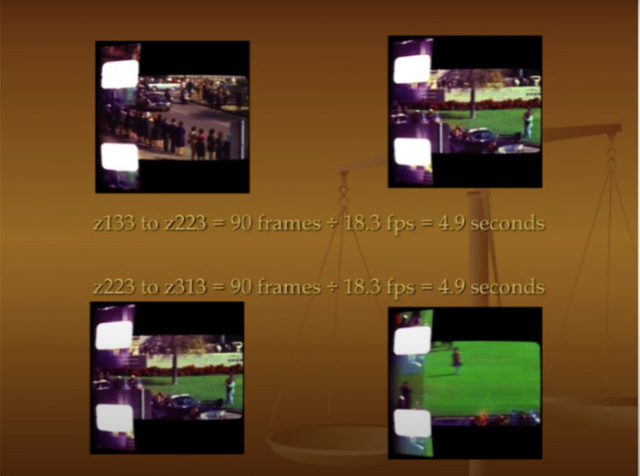
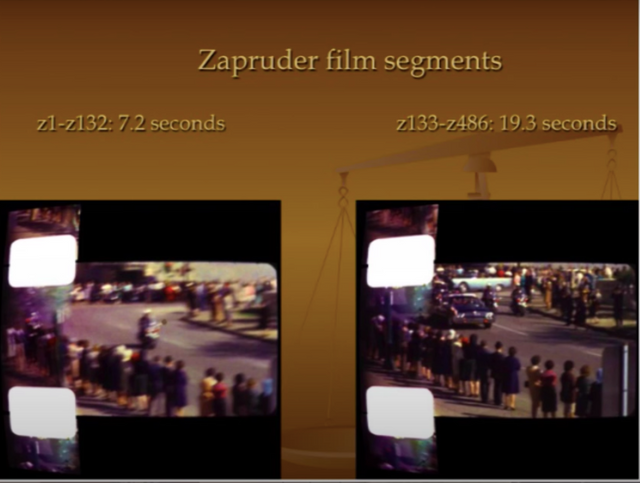
Holland wondered how something could not be on the Zapruder film.
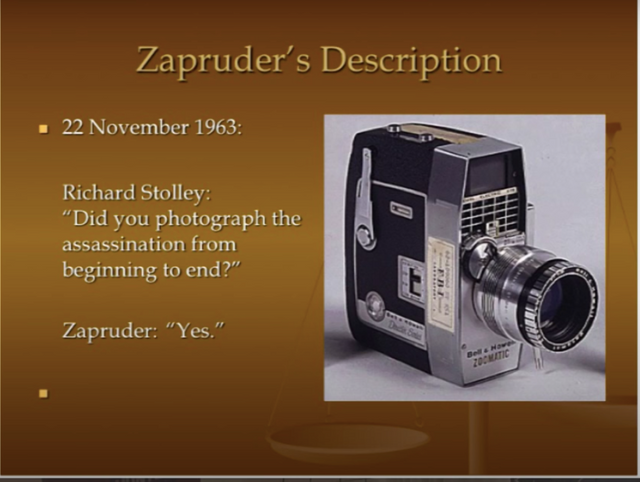
One writer stated, "The Zapruder film was the holy relic of presidential martyrdom."
"It documented the last moments of American idealism and innocence, a testament to government ineptness at best, a nefarious conspiracy at worst."
Holland started wondering, what is the basis for thinking that all three shots have to be on the Zapruder film?
A Dallas Times Herald Reporter Named Darwin Payne, his office wasn't even 10 minutes from Dealey Plaza. As soon as he heard the police bulletin of shots fired he raced over there. The second person he talked to happened to work for Abe Zapruder and told him of the possibility of this film.
The third person Payne interviewed was Zapruder.
These are his notes from that interview not even 20 min. after the assassination.
I got film.
The president slumped over with the first shot.
At the first shot he bent over and grabbed his throat.
The 2nd of 2 shots hit him in the head.
He couldn't be alive.
She was beside him after the last shot.
She crawled over the back of the car.
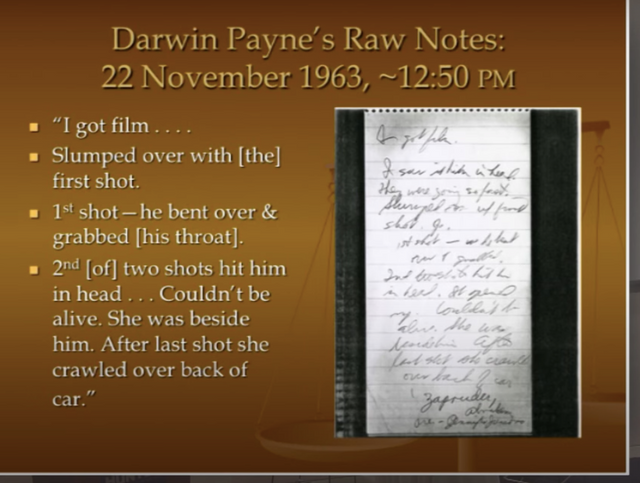
What is apparent is that Zapruder's 1st shot, is actually the 2nd shot.
And his 2nd shot was the third shot.
Was it that he simply didn't hear the first shot?
They found 3 cartridges on the 6th floor of the Texas Book Depository.
Most there at Dealey Plaza heard 3 shots.
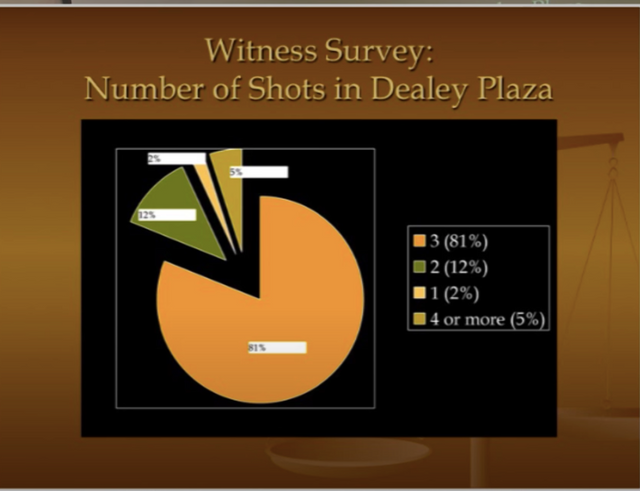
Most people not familiar with firearms, didn't recognize the first pop as the sound of a rifle shot.
Not on the Zapruder film.
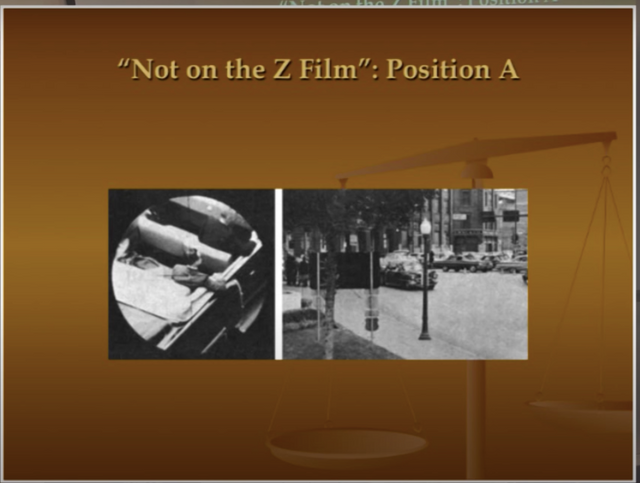
Had the shooting sequence been conflated with the film when it was possible they were two different things?
There was a phrase Holland had heard from Scheniefeld. Scheniefeld was the FBI agent, who helped the Warren Commission do the reconstruction.
At the reconstruction in 1964. To their surprise, the sillouette of the president's upper torso came into Oswald's line of sight at a point Before the Zapruder film!
They labeled this position A.
This is a still from a Secret Service re-staging that took place on November 27, 1963.
It was not done for investigative criminal purposes.
It was done to show the agents back in Washington D.C. and elsewhere what had happened so it wouldn't happened again.
They filmed the car, a white Lincoln Continental that wasn't as long as the limo the president was in, going through Dealey Plaza with a still and moving picture camera.
Marine's are taught [Oswald was an ex marine]to aim at the upper body mass.
You don't aim at a head or an arm, you aim at an upper body mass!
The ghost car which Holliday inserted into the photo, is the car when Zapruder restarted his camera.
Then you realize that whole turn into Dealey Plaza, Zapruder didn't film.
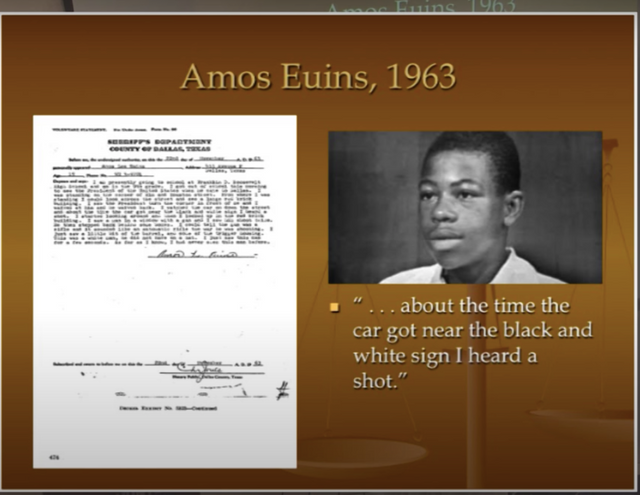
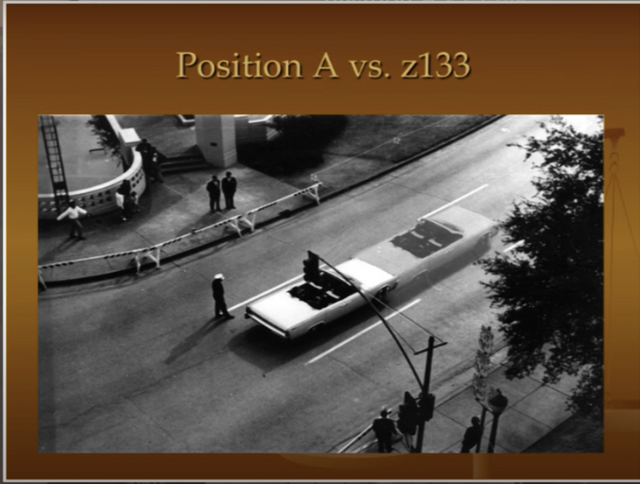
Amos was one of the few witnesses from Dallas brought up to D.C.
The reason was, when everybody raced up the grassy knoll, he told police, "You're going to the wrong place! There was a rifle in that window."
This was Amos' statement to the Sheriff's Department that afternoon, "about the time the car got to the black and white sign I heard a shot.
Amos was one of the very few people who put the shot in space where the president was when he heard the first shot.
Holland was able to interview him later in life.
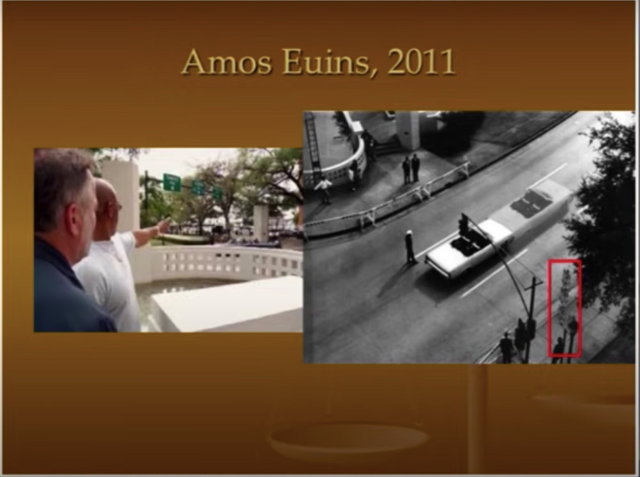
The signs were old US Highway signs which are no longer in Dealey Plaza as they were replaced by US Highway signs. You can see them in the Secret Service restaging.
Concerning the ejected cartridges, two under the window sill of the 6th floor of the book depository and another several feet away.
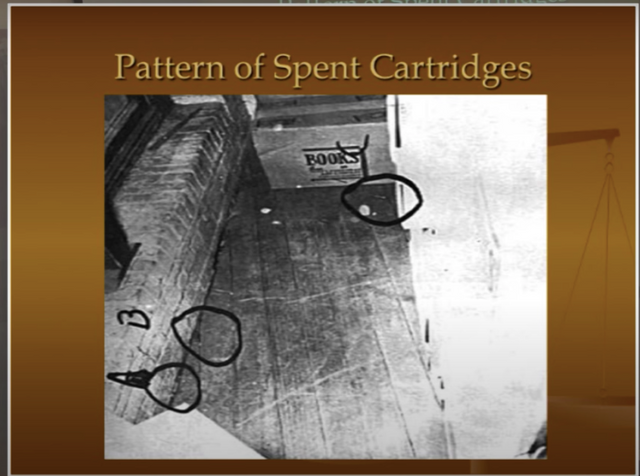
It's standard procedure that cartridge ejection patterns can be used to utilize the specifics of a shooting.
National Geographic hired a marine reservist, who was roughly the same height as Oswald and he tried to replicate the shell casing pattern.
When rifle was perpendicular to the building the shell casing came right back, but when shifting to shoot further down Elm Street, both cartridges hit the books that Oswald piled up to hide himself and they fell against the window sill.
Exactly the pattern the shells were discovered on November 22, 1963.
For a 20 time run through 17 to 18 times they fell in exactly that pattern.
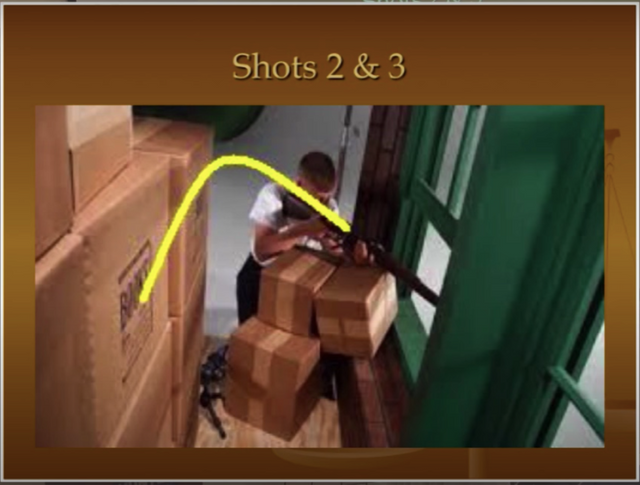
Corroboration of a shot being fired prior to what was called on the Zapruder film.
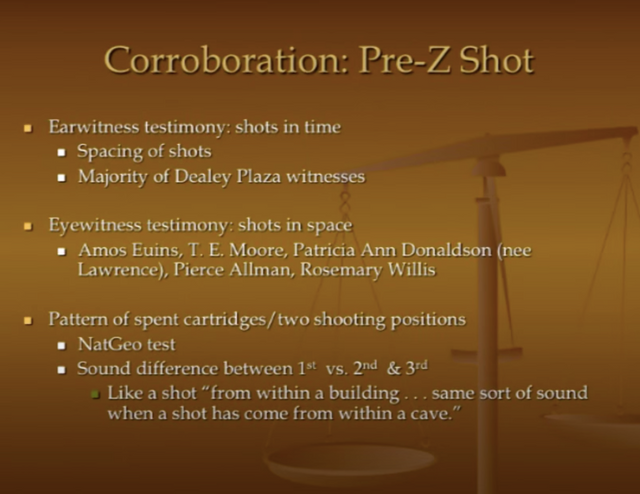
Turns out the Zapruder film itself impeaches the idea of the Zapruder film capturing all three shots.
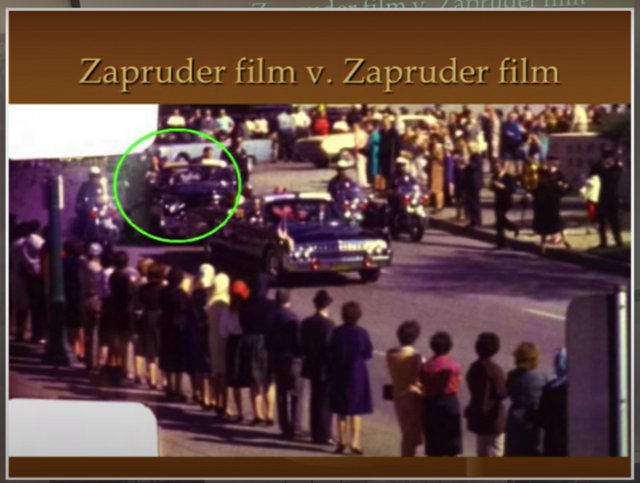
If you look in the follow up car brimming with Secret Service agents.
There was an eye witness named Malcom Summers, you can see him in this frame falling to the ground after the 3rd shot,
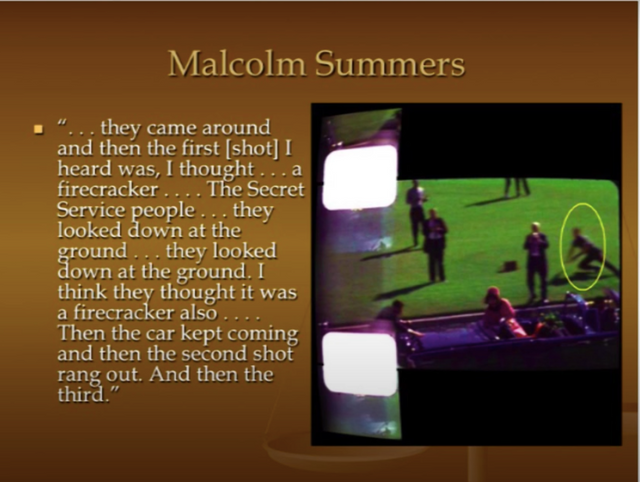
An oral history says, "they came around and then the first shot I heard, was I thought. . .a firecracker. . .the Secret Service people. . .they looked down at the ground. . .they looked down at the ground. I think they thought it was a firecracker also. . .then the car kept coming and the 2nd shot rang out, and then the third."
If you look at George Hickey from the film around frame 144/145 he leans way over the car. When you read his testimony he talks about how he thought a firecracker had been thrown at the car and he was looking for it.
If he was moving by frame 144 doesn't that mean something would have had to happen prior?
The firecracker didn't just fire at his ear, he had to recognize it as a sound that didn't belong. Then the brain decides what to do in reaction.
His brain had to tell him muscles to move, then his body had to move his muscles.
All of that takes time, it is not immediate.
Therefore, would take a second to a second and a half.

The Zapruder film pushes that it was before 133. WHY? You already know!
Once unlocked from the agenda of believing the Zapruder film captured all three shots, it also explains why Oswald missed so badly.
And some of the ballistic phenomena associated exclusively with the first shot.
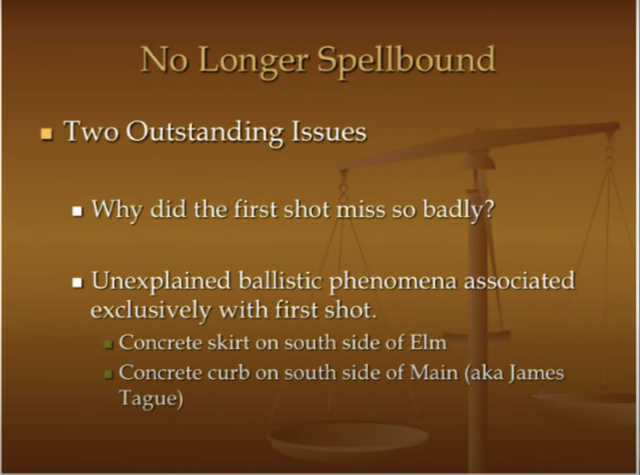
As far as the concrete skirt, the grass had been disturbed. South side of Elm Street.
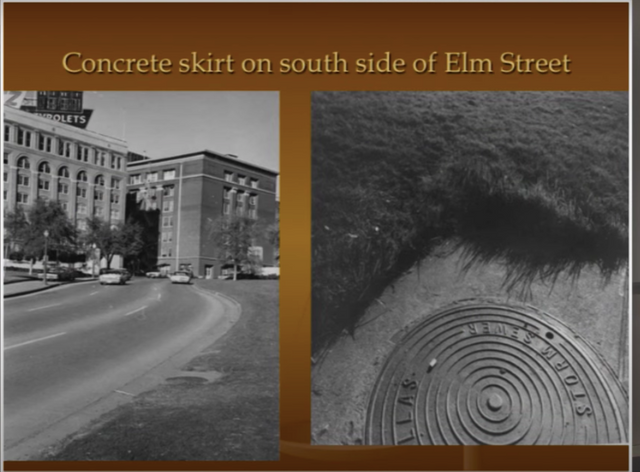
There were several photos after the assassination of officers picking at this grass.
They were looking for evidence of a bullet, they found nothing. The bullet had just gone through a couple inches of the turf.
This was the mark on the curb far down from Dealey Plaza near the underpass.
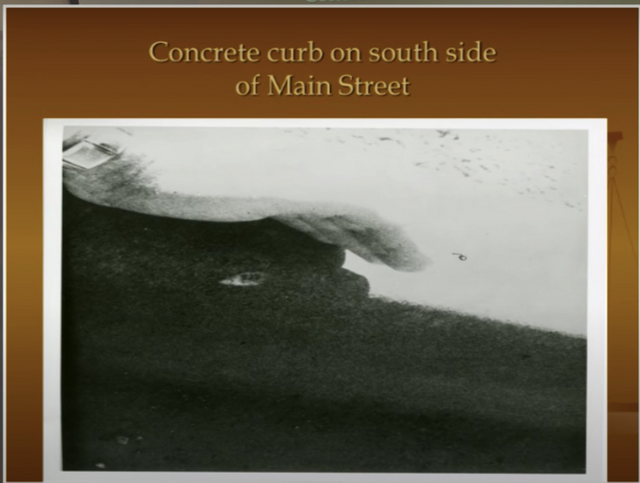
The man with the arrow pointing to him is James Tague.
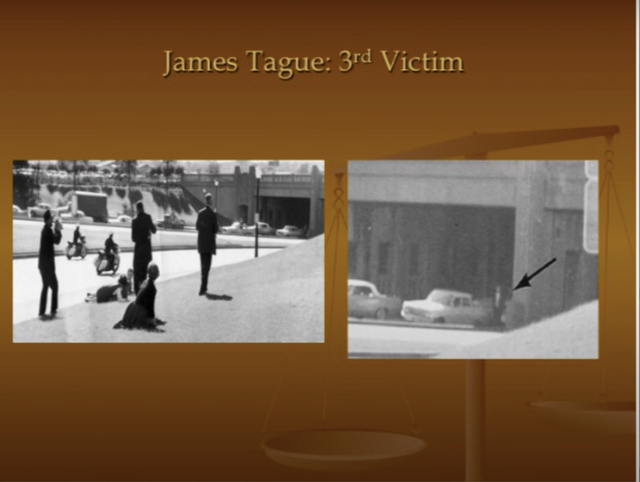
This was the victim, who had been cut on the cheek.
Here is Tague's view back towards the book depository.
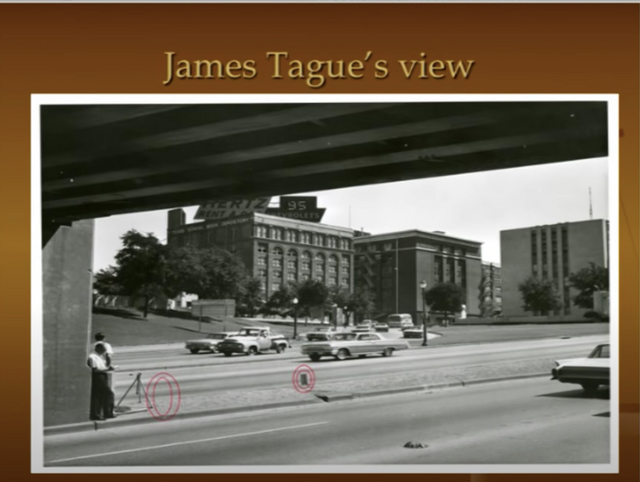
The bag circled is the curb where the bullet hit.
The other circle is about where Tague was standing.
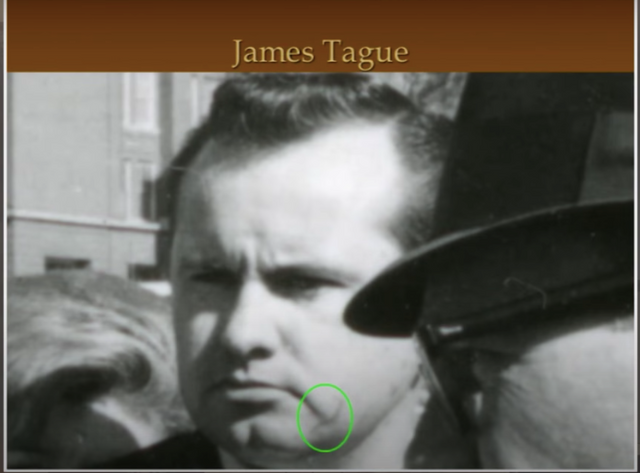
When the Secret Service did it's Restaging on November 27, 1963, they ran the car through Dealey Plaza first in slow motion, then at the speed of the limosouine.
Then they put the camera in the car and pointed it at the window.
That's when there are no denying there are two obstacles when dealing with Dealey Plaza.
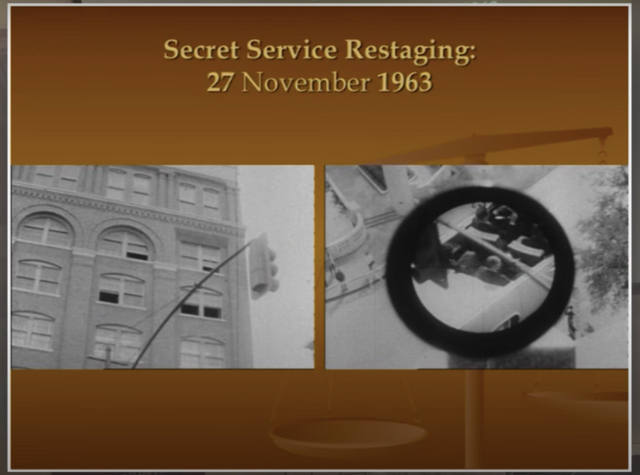
One is the Oak Tree
the other, the two inch steel pipe as part of the traffic light assembly at the corner.
Capable of deflecting a bullet? You decide!
In 2012 with the assistance of National Geographic, Holland went up on a lift to do the first inspection ever of the armast.
Frank Leronjay, former unit chief of ballistics
John Joe Hallut, the agent who shot the Secret Service restaging film.
This was not a forensic inspection as they didn't have the authority to shut off traffic.
Years later there was a lot of signage attached to the mast arm.
The tree had grown much larger and was in the way.
After the program was broadcast in November 2012, Frank and Holland started writing letters to the FBI as it had never been inspected by authorities.
They requested the traffic assembly be taken down. They cost between 12 to $15,000.
They offered to purchase it from the city of Dallas, but they wouldn't consider it.
They were afraid something would happen to the light and they wouldn't get a chance to inspect it.
On July 2012, Holland got a call from Dallas as they never gave up requested to purchase the light or have it investigated, a car had hit the traffic assembly and knocked it down.
Holland and Frank headed to Dallas, though it was 103 degrees in the shade that day, they spent all day in the sun.
There were three layers of paint on the arm mast that had been painted very haphazardly.
Eventually Parks and Recreation, who had ownership of the mast put it in a shed.
Here is Frank during one of their inspections.
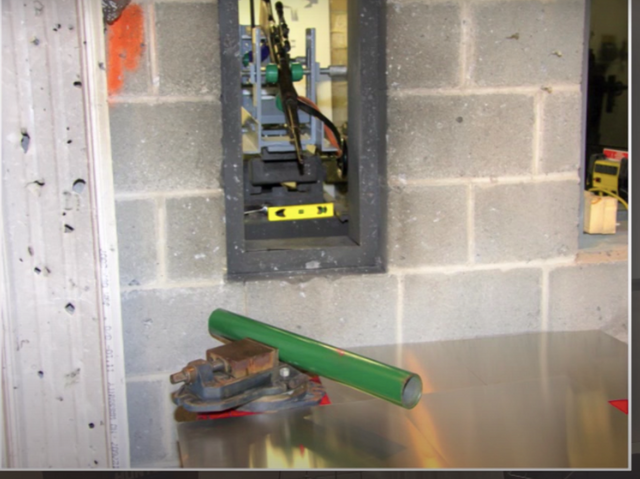
One of the most important things they were able to accomplish within the National Geographic show was that they were able to measure the angles.
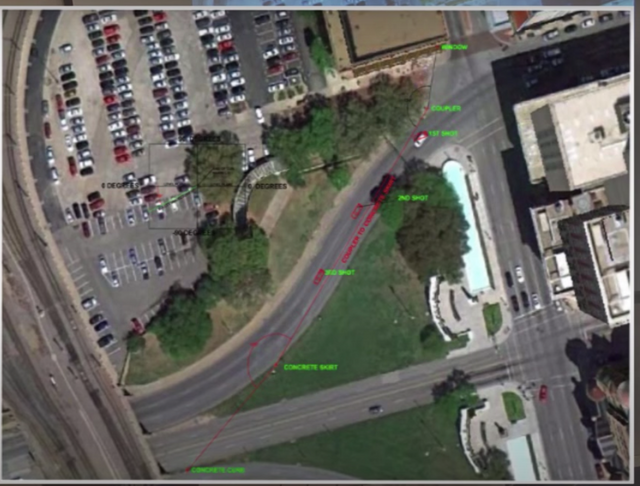
They were never able to find an indentation that made them think it was it.
As they were essentially looking for a needle in a haystack, with the cooperation of H.P. White, the same ballistics company that had assisted CBS in 1967, they were able to take a Mannlicher Carcano and fire it at exemplars of the mast.
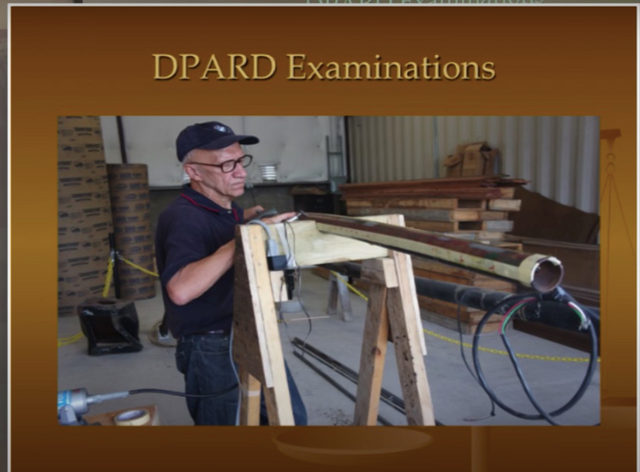
1/16th of an inch difference makes a huge impact on the results.
With test #3 they were able to get the deflection they were looking at.
They had to take into account corrosion over the years.
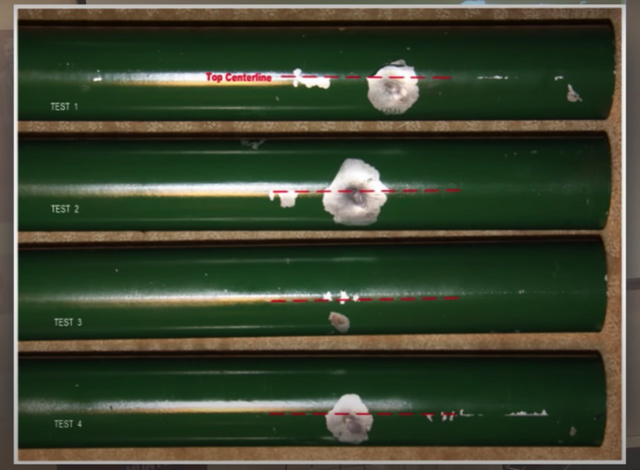
This was the area of the mast arm they decided was the most likely area of impact ultimately.
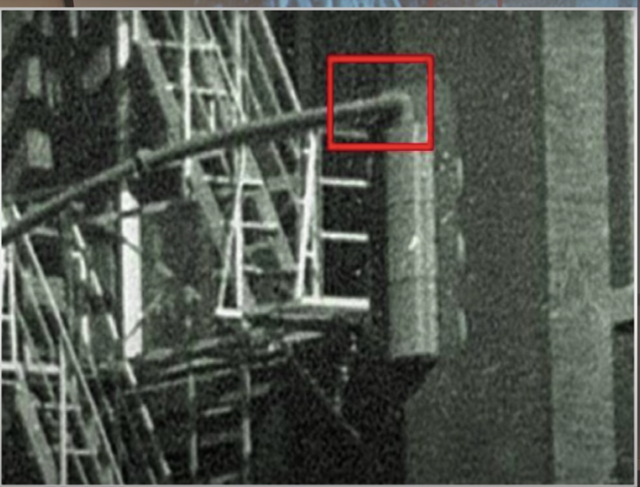
This was the final explanation developed from the testing.
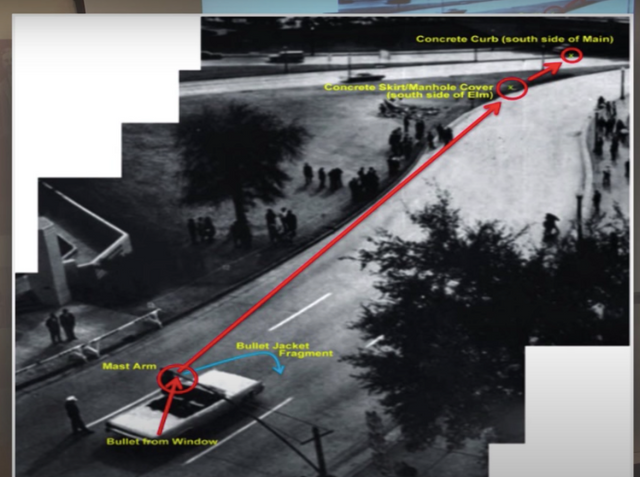
Oswald fired as soon as position A was achieved.
He had waited the whole time the car was coming toward him.
As soon as it turned away from him and as soon as he had the optimal silhouette was when he fired the shot.
Whether the sight wasn't sighted correctly at that distance or the mast arm got in the way or he didn't get it fired off correctly, it didn't hit the car nor anyone in the car.
Instead it went way down in Dealey Plaza, caused the burst of debris at the skirt, then hit the curb where Tague was standing.
The reason there was a pause from what Lawson heard, was because Oswald could not work the bolt fast enough to fire again before the car went under the tree. He had to wait until it cleared the tree, then he could fire the second and third shots.
Holland ends with a quote, which is apt, but did he ask ALL of the right questions through his investigation?
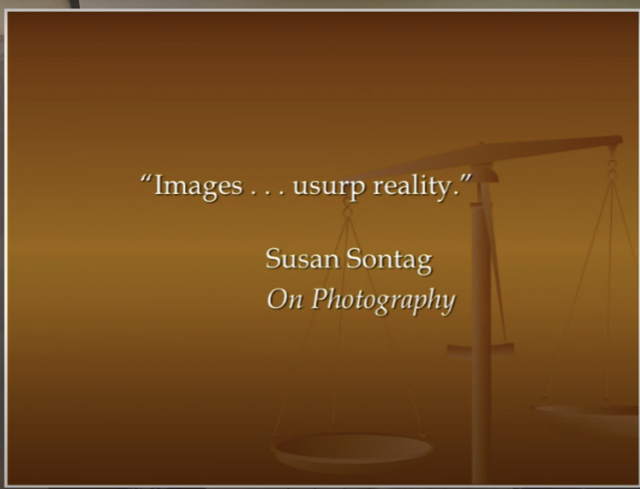
Many still have questions. . .was Oswald connected to the CIA, Globalists?
Is he really attempting to give the Warren Commission credence?
Why did the CIA during that time coin the phrase "Conspiracy Theorist" in direct response to those who dared question their narrative?
Isn't it curious the people who died in connection?
Did they know too much.
Interesting spots on the motorcade walk pointed at during
Too late to Apologize! The Called Makings of a Perfect Day
https://www.bitchute.com/video/E0mhZgvd6Rkr/
The bodies like the FBI and the House findings. . .how often have they found to NOT be trustworthy?
How does Holland know the Mafia didn't kill Kennedy?
What was the real deal behind Jack Ruby and his connections?
Was Oswald just an innocent bystander as depicted by Oliver Stone?
Why wasn't the fact that a police officer died within minutes of Kennedy the same day?
Why was Kennedy's coffin thrown into the sea?
Why wouldn't LBJ allow Jacqueline to see her husband's body?
Was the excuse that he needed to be sworn in more important than seeing her husband's body?
A closer look at 2 of the 3 men murdered on the day of the JFK assassination. What a job by those Dallas Police, just 1:22 and the assassin is found. Is that peculiar?
The Zapruder Film Mystery
Interesting headline considering the Oak Tree on Dealey Plaza? You decide as we already know #ThereAreNoCoincidences
From the Dallas Morning News
Marie Tippit, widow of Dallas police officer gunned down by Lee Harvey Oswald, dies at 92
JFK’s assassin killed Tippit’s husband, Officer J.D. Tippit, on an Oak Cliff street shortly after leaving Dealey Plaza.
RFK Jr: Truth about my father's killing still kept secret
Sources and Connecting Articles
https://nypost.com/2016/12/04/dorothy-kilgallens-tell-all-on-a-mafia-don-might-have-got-her-killed/
https://www.coasttocoastam.com/guest/shaw-mark-84614/
https://www.amazon.com/Hollywood-Godfather-Life-Movies-Mob/dp/1250181399
https://www.opednews.com/articles/THE-JFK-CASE--THE-TWELVE-by-Bill-Simpich-120825-173.html
https://jfkfacts.org/the-origins-of-mannlicher-carcano-bullets/
JFK the Truth, Evidence and Witnesses who had a different story to tell than MSM and the Warren Commission! A teacher's story the WC tried to change. More than half heard shots from Grassy Knoll.
The Kennedy's were quite skilled at hiding people when they needed to. JFK's sister, at first they claimed she was a teacher, but she ended up in a home after a lobotomy!
Remember when President JFK vowed to "Splinter the C_a into a thousand pieces & scatter them in the winds?" Any Wonder this corrupt org which stands to lose Everything if fully Exposed would call those exposing them Conspiracy Theorists? You decide!
The people connected in their own Election Fraud scandal back in the day before JFK. . .but integral in placing LBJ and Connally in position for one fateful day!
Philadelphia Experiment precursor to Montauk. JFK's severed ship and his Island Plum Pudding